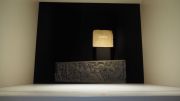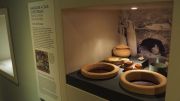In this corridor there are four niches dedicated to four cultural aspects very important for Roman society: the death, the religion, the cuisine and the domus.
Concerning the death, there is a Roman epigraph of a local noblewoman named Valeria Camilla, and the reproduction of a sarcophagus of the 3rd century A.D. that is now stored in Pieve di Camaiore, both findings come from Lombrici (Camaiore).
On the other side there is a reflection on Roman religiosity, that has to face the delicate transition from a Pagan religion, where the gods didn’t care about the human beings, to the Christian religion,
where the humans become the protagonists.
Mysterious religious practices taken from Greeks and the East promote these processes, that are based on a close relationship between the god and the devote person. This relationship starts with an initiation ritual and the oath of secrecy. In this niche there are also: a small “lararium” and other musical instruments used during religious rituals. We can hears the sounds of this ancient instruments.
This niche, instead, reproduce the termopolium of Pompei: food in Roman world represents a very important element: it’s a symbol of wellness and of high social status, but also an occasion of meeting and debate among common people.
The main course was the dinner, that rich families used to have while laying on the triclinium, served by slaves.
However it was a common thing also to eat out, buying food in bakeries, or shops that sold wine and cereals’ soups, or in tabernae, small taverns.
The last niche is dedicated to the domus‘ luxury, through richly decorated rooms with paintings in “false architecture” style. In the niche there are reconstructions of objects and instruments used in the important moment of otium, that is the pause taken from political commitments.
They spend their time playing with dices and pawns.
There are pottery and glass containers for the banquet, and musical instruments.








